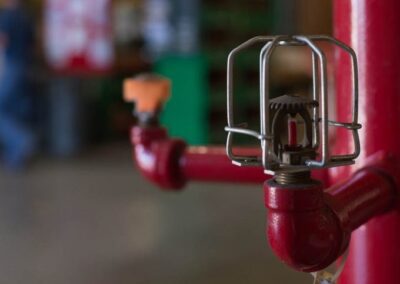Corrosion is a common cause of fire sprinkler system malfunction or failure. When oxygen is present in the piping of a system, it reacts with water and the metal of the piping, which creates solids that corrode. Many people believe that corrosion is caused primarily by microbiologically-influenced corrosion (MIC). The solids produced by the reaction with oxygen create an environment in which bacteria can easily increase within the system. However, the ultimate cause is oxygen.
Corrosion in Wet and Dry Pipe Fire Sprinkler Systems
Oxygen dissolves into water naturally. In a standard 1,000-gallon wet fire sprinkler system, any oxygen that is confined within the pipes will be absorbed. It takes 30 days for that dissolved oxygen to create roughly 34 pounds of solids. In wet systems, the solids sink to any low spots and begin to corrode. If fresh oxygen is ever introduced into the system, the process begins again, adding more and more solids to the system.
Dry and pre-action systems aren’t immune to corrosion problems. In fact, corrosion is more common in dry pipe systems due to the higher levels of oxygen present. Moisture in the system from testing or condensation interacts directly with the iron in the pipe, causing corrosion.
Agents That Accelerate Corrosion
There are six agents that will accelerate the rate of corrosion:
- Oxygen becomes available: Oxygen will instantly cause metal loss when air dissolves in the water.
- Solids in the piping: Corrosion will become more aggressive, and pitting attack of the pipe wall will occur. Solids provide an ideal environment for bacteria to colonize.
- MIC in your system: There are many mechanisms that come under the heading microbiologically influenced corrosion, and they can accelerate the process.
- Mechanical deposit removal: A fresh new site for oxygen attack can occur when the pipe is removed to be cleaned mechanically.
- Draining and refilling the system: When a wet fire sprinkler system is drained and filled with water, the oxygen level that exists with the fresh supply of air will remove more metal from the pipe walls.
- The low pH of condensate (dry and pre-action systems): When the temperature alternates, compressed air in the system falls beneath the dew point, and water will condense into small droplets that expedite corrosion.
Solids and Bacteria
Bacteria exist in water naturally. This leads many to believe that MIC is generally responsible for corrosion. While it does occur, and the solids produced by the dissolved oxygen’s reaction with the metal produces an environment for bacteria to grow more quickly, MIC is nearly always a secondary cause of corrosion. The presence of oxygen in the fire sprinkler system is typically the primary cause of corrosion.

